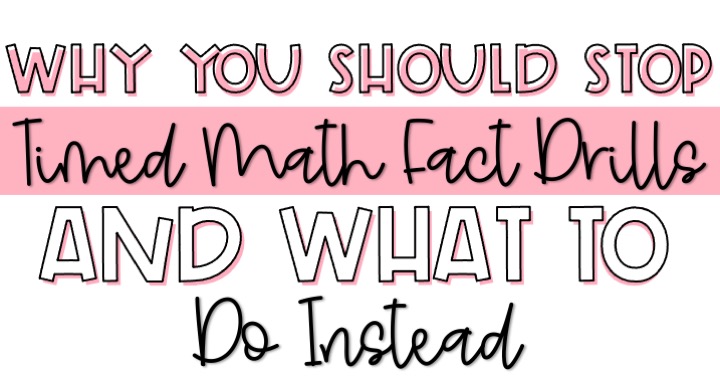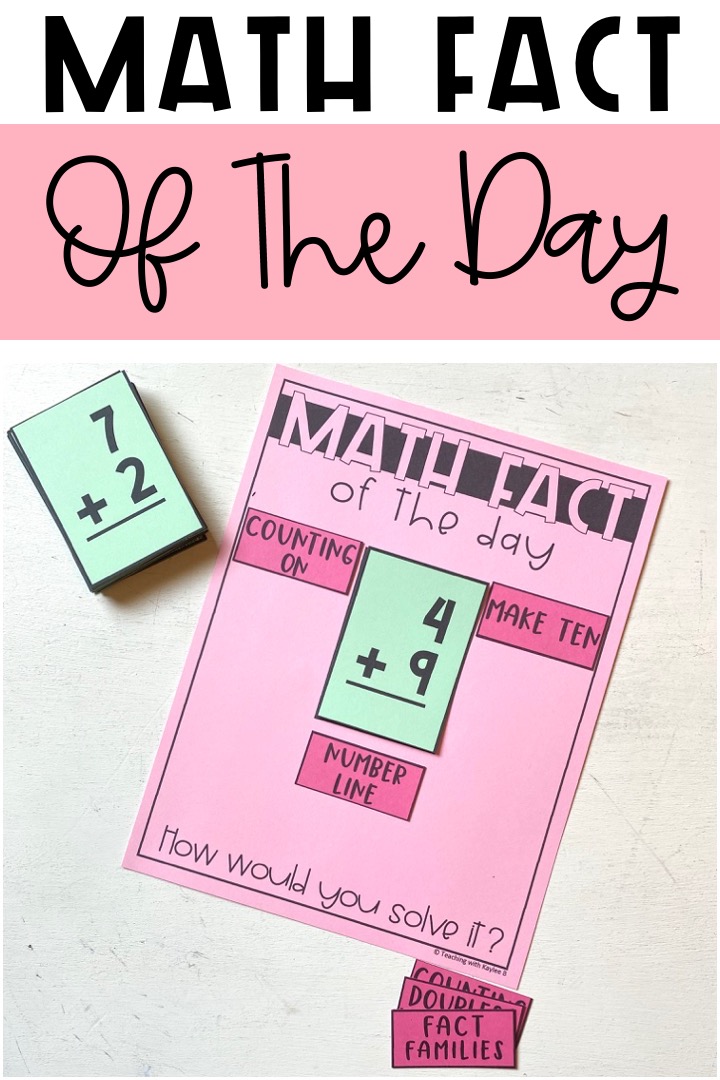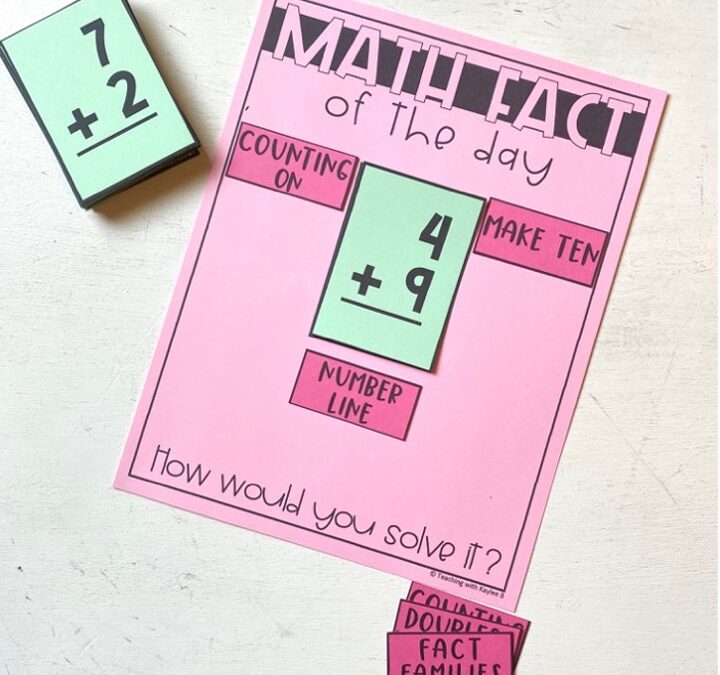Timed math fact drills are when you give your students a sheet with 25 or more math facts and then time them for a minute to complete all of them. Often teachers have students practice these math fact drills daily and then test them at the end of the week.
Research has shown that math facts speed drills don’t benefit students. They actually cause more harm than good. Let’s go over why you should stop timed math fact drills and what to do instead.

Math Fact Drills
If students don’t know how to find the answer to a math fact, timed tests create a lot of anxiety in students.
The timer was counting down. There was about a minute left on the clock while my students frantically wrote answers down on a math fact timed test. I started to weave in between the rows of desks as I noticed one student writing random numbers. I leaned near her and whispered to her. I told her to not just write random numbers and to work through each problem.
I walked around the rows once more and I realized that this student now had her hands covering her face and that she was sobbing. I asked her to talk to me in the hallway.
I asked her why she was upset. She told me it’s because she didn’t know any subtraction facts. I reassured her that is why we have strategies to figure them out. I asked her what strategy she wanted to use. But she just shook her head because she didn’t know any.
I felt bad for this student. No wonder she was just writing random answers. It was her coping mechanism to try to hide that she didn’t know the facts. I felt bad because she didn’t have the tools to find the answers and be successful. It was my fault she didn’t know how to do any strategies.
I wanted her to find confidence in her skills. I wanted to help each and every one of my students find success.
I decided to make this happen, I needed to change how I taught math facts and how my students practiced math fact fluency. This student wasn’t going to get any better if she sat their writing random numbers on a timed test. I knew I needed to teach math fact strategies in my classroom.
We worked on a couple different subtraction strategies the next few days. I set out different math fact games for my students to practice these strategies on their own.
And let me tell you… this made all the difference! A few days later when my class was taking that timed test, this student finished every problem with a minute to spare! And the best part… Every answer was correct! She beamed with happiness. She had the tools to be successful.
So what made the difference?
The difference was now she could discover the answer to facts by herself. She didn’t have to worry if she forgot a fact in the moment because she could quickly figure out the answer. As she did math fact strategies, she saw patterns and relationships within the facts and committed those facts to memory.
Timed math fact drills don’t help students be flexible with numbers or create number sense. They just memorize “symbol plus symbol equals symbol.” And when they come to a pressured situation, they will likely forget the memorized fact.
Students just memorize for the test and prizes and it will not stick.
Have you ever crammed for a test and memorized the answers to a study guide just minutes before a test? I sure have. And let me tell you. I dumped everything about that subject after I got a grade on the test.
Same thing with math facts.
Students use rote memorization for math fact timed tests, then they forget and can’t apply those facts when they are needed later. These tests put students in pressured situations where they begin to feel math anxiety.
Students shape their view around math based on math fact speed drills.
Students get the ideas that they are only good at math if they are fast at math. They see that math is only about memorization. But really math is so much more. It’s about problem solving and using different methods to reason through the numbers.
I’ve talked to people who never thought they were a “math person” because they struggled with timed tests and math anxiety. So… Let’s not turn our students away from math. Let’s let them discover their greatness with it.
We can do this by dumping the math fact speed drills and focusing and other things instead.
What to do Instead of Math Fact Speed Drills
Focus on teaching strategies. Instead of using the class time to drill students on tests or flash cards, actually teach students math fact strategies. Then when students come to a math fact that they forgot in the moment, they can quickly use a strategy to figure it out.
After students use the strategies, they begin to see the patterns and relationships between the facts. They begin to commit the facts to memory in a meaningful way that will actually stick with them.
When teaching students the math fact strategies, I like to explicitly teach them. Then I give my students plenty of practice with task cards and worksheets. I hang up anchor charts to help students remember how to use them.

Read about all the math fact strategies I teach in my classroom here in this blog post: Meaningful Math Fact Strategies That Work
I also give students exit tickets where they show me where they are at with each strategy. This helps me know what to reteach and what to review. Find my math fact strategies resources here.
It’s important to model using strategies daily. That’s why I do a daily math warm up called “Math Fact of the Day.” I simply put up a math fact and then I ask “How would you solve it?” I give students a moment to think about it by themselves, then I have them turn and talk to a partner to show how they would solve it. I love to hear them talking about their reasoning!
Then I’ll call on a few students to share with the class their reasoning. I’ll write up on the board the numbers they are saying so other students can follow along. Doing this daily helps students practice using math fact strategies when they are working with math facts on their own.

Find my Math Fact of the Day resource here.
Once I teach math fact strategies to my students, I like to give them lots of practice applying them in fun ways with math fact games. I set these out as center activities or as fast finisher activities. Here are a few examples of games that my 2nd grade students love.
Math Fact Drill Games

Math Fact Bingo
This game you can play with the whole class or students can play in small groups. Each student playing gets a bingo card. The bingo cards have sums 1-20, then someone pulls out a call card and says the equation. Students have to figure out the answer to know what space to cover up. Five in a row makes bingo! Find this Math Facts Bingo game here.
Math Fact Board Games
This game is kind of like Candy Land. The board game has sums, and then students take a card with an equation. They go to the next spot with the sum. Find this Math Facts Board Game here.
Math Fact War
Students get in small groups and pass out the cards evenly. They put their cards into a stack and on the count of 3 flip over their top card. The card with the greatest sum gets the cards in that round. Students keep playing until one person has all the cards or until time is up. Find the addition version of this game here and the subtraction version here.
Find all of my math fact games in a money saving bundle here.
I hope that this blog post has been able to help you see why you should stop using math fact drills in your classroom and what beneficial things you should do instead.
For more help to getting your students fluent with addition and subtraction math facts, check out my free resource perfect for 1st and 2nd grade teachers: The 7 Steps to Ensure Math Fact Fluency

Download your free copy here.


